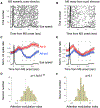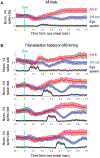Enhanced Neural Processing by Covert Attention only during Microsaccades Directed toward the Attended Stimulus
- PMID: 29937279
- PMCID: PMC8415255
- DOI: 10.1016/j.neuron.2018.05.041
Enhanced Neural Processing by Covert Attention only during Microsaccades Directed toward the Attended Stimulus
Abstract
Attention can be "covertly" directed without eye movements; yet, even during fixation, there are continuous microsaccades (MSs). In areas V4 and IT of macaques, we found that firing rates and stimulus representations were enhanced by attention but only following a MS toward the attended stimulus. The onset of neural attentional modulations was tightly coupled to the MS onset. The results reveal a major link between the effects of covert attention on cortical visual processing and the overt movement of the eyes.
Keywords: IT; V4; attention; firing rate; microsaccades; object decoding; oculomotor system; visual cortex.
Copyright © 2018 Elsevier Inc. All rights reserved.
Conflict of interest statement
DECLARATION OF INTERESTS
The authors declare no competing interests.
Figures





Similar articles
-
Stimulus representations in visual cortex shaped by spatial attention and microsaccades.Proc Natl Acad Sci U S A. 2025 Jun 3;122(22):e2420704122. doi: 10.1073/pnas.2420704122. Epub 2025 May 27. Proc Natl Acad Sci U S A. 2025. PMID: 40424126 Free PMC article.
-
Eye movement preparation modulates neuronal responses in area V4 when dissociated from attentional demands.Neuron. 2014 Jul 16;83(2):496-506. doi: 10.1016/j.neuron.2014.06.014. Neuron. 2014. PMID: 25033188 Free PMC article.
-
Microsaccadic eye movements and firing of single cells in the striate cortex of macaque monkeys.Nat Neurosci. 2000 Mar;3(3):251-8. doi: 10.1038/72961. Nat Neurosci. 2000. PMID: 10700257
-
The significance of microsaccades for vision and oculomotor control.J Vis. 2008 Dec 18;8(14):20.1-21. doi: 10.1167/8.14.20. J Vis. 2008. PMID: 19146321 Free PMC article. Review.
-
Dissociable Cortical and Subcortical Mechanisms for Mediating the Influences of Visual Cues on Microsaccadic Eye Movements.Front Neural Circuits. 2021 Mar 11;15:638429. doi: 10.3389/fncir.2021.638429. eCollection 2021. Front Neural Circuits. 2021. PMID: 33776656 Free PMC article. Review.
Cited by
-
Emerging order of anomalous eye movements with progressive drowsiness.J Vis. 2023 Jan 3;23(1):17. doi: 10.1167/jov.23.1.17. J Vis. 2023. PMID: 36696121 Free PMC article.
-
Directing Voluntary Temporal Attention Increases Fixational Stability.J Neurosci. 2019 Jan 9;39(2):353-363. doi: 10.1523/JNEUROSCI.1926-18.2018. Epub 2018 Nov 20. J Neurosci. 2019. PMID: 30459223 Free PMC article.
-
Functional Specialization in the Attention Network.Annu Rev Psychol. 2020 Jan 4;71:221-249. doi: 10.1146/annurev-psych-010418-103429. Epub 2019 Sep 12. Annu Rev Psychol. 2020. PMID: 31514578 Free PMC article. Review.
-
A Rhythmic Theory of Attention.Trends Cogn Sci. 2019 Feb;23(2):87-101. doi: 10.1016/j.tics.2018.11.009. Epub 2018 Dec 24. Trends Cogn Sci. 2019. PMID: 30591373 Free PMC article. Review.
-
Pre-stimulus activities affect subsequent visual processing: Empirical evidence and potential neural mechanisms.Brain Behav. 2025 Feb;15(2):e3654. doi: 10.1002/brb3.3654. Brain Behav. 2025. PMID: 39907172 Free PMC article. Review.
References
-
- Bair W, and O’Keefe LP (1998). The influence of fixational eye movements on the response of neurons in area MT of the macaque. Vis. Neurosci 15, 779–786. - PubMed
-
- Chen CY, Ignashchenkova A, Thier P, and Hafed ZM (2015). Neuronal response gain enhancement prior to microsaccades. Curr. Biol 25, 2065–2074. - PubMed
Publication types
MeSH terms
Grants and funding
LinkOut - more resources
Full Text Sources
Other Literature Sources

